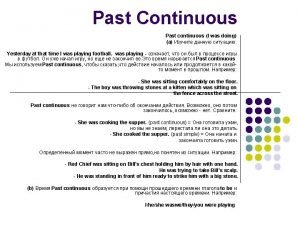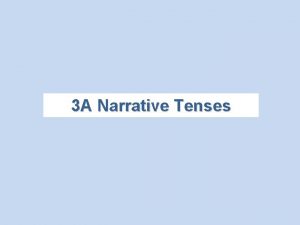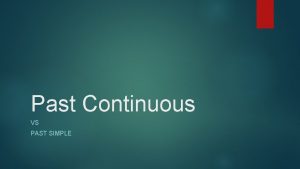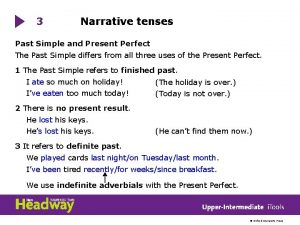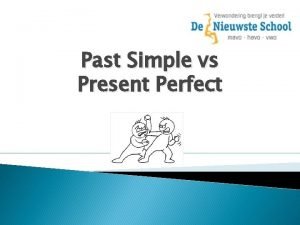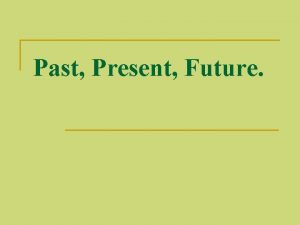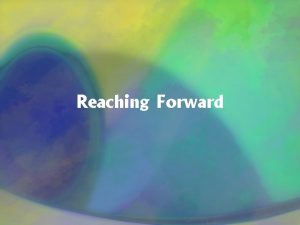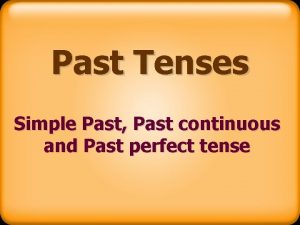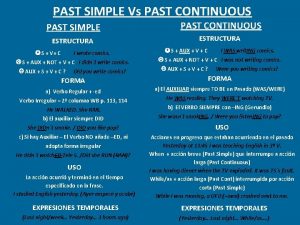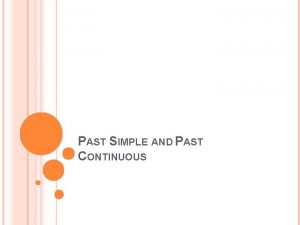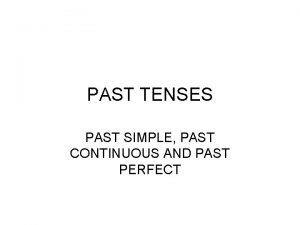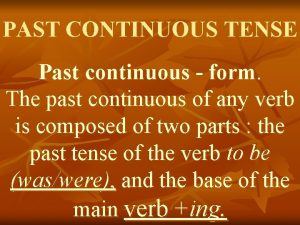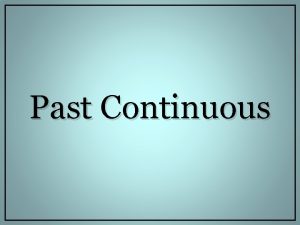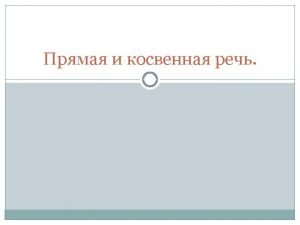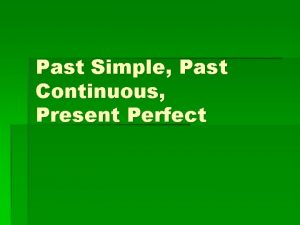Present Continuous Past Continuous Future Continuous Present Continuous

![Present Continuous FORM [am/is/are + present participle] Examples: You are watching TV. Are you Present Continuous FORM [am/is/are + present participle] Examples: You are watching TV. Are you](https://slidetodoc.com/presentation_image_h/9c8781b143d9cf8f268405f05d48e470/image-2.jpg)




![Past Continuous FORM [was/were + present participle] Past Continuous FORM [was/were + present participle]](https://slidetodoc.com/presentation_image_h/9c8781b143d9cf8f268405f05d48e470/image-7.jpg)










- Slides: 17

Present Continuous Past Continuous Future Continuous
![Present Continuous FORM amisare present participle Examples You are watching TV Are you Present Continuous FORM [am/is/are + present participle] Examples: You are watching TV. Are you](https://slidetodoc.com/presentation_image_h/9c8781b143d9cf8f268405f05d48e470/image-2.jpg)
Present Continuous FORM [am/is/are + present participle] Examples: You are watching TV. Are you watching TV? You are not watching TV.

USE 1 Now Use the Present Continuous with Normal Verbs to express the idea that something is happening now, at this very moment. It can also be used to show that something is not happening now. Examples: You are learning English now. You are not swimming now.

USE 2 Longer Actions in Progress Now In English, "now" can mean: this second, today, this month, this year, this century, and so on. Sometimes, we use the Present Continuous to say that we are in the process of doing a longer action which is in progress; however, we might not be doing it at this exact second. Examples: (All of these sentences can be said while eating dinner in a restaurant. ) I am studying to become a doctor. I am not studying to become a dentist. I am reading the book Tom Sawyer.

USE 3 Near Future Sometimes, speakers use the Present Continuous to indicate that something will or will not happen in the near future. Examples: I am meeting some friends after work. I am not going to the party tonight.

USE 4 Repetition and Irritation with "Always“ The Present Continuous with words such as "always" or "constantly" expresses the idea that something irritating or shocking often happens. Notice that the meaning is like Simple Present, but with negative emotion. Remember to put the words "always" or "constantly" between "be" and "verb+ing. " Examples: She is always coming to class late. He is constantly talking. I wish he would shut up.
![Past Continuous FORM waswere present participle Past Continuous FORM [was/were + present participle]](https://slidetodoc.com/presentation_image_h/9c8781b143d9cf8f268405f05d48e470/image-7.jpg)
Past Continuous FORM [was/were + present participle]

USE 1 Interrupted Action in the Past Use the Past Continuous to indicate that a longer action in the past was interrupted. The interruption is usually a shorter action in the Simple Past. Remember this can be a real interruption or just an interruption in time. Examples: I was watching TV when she called. When the phone rang, she was writing a letter. While we were having the picnic, it started to rain.

USE 2 Specific Time as an Interruption In USE 1, described above, the Past Continuous is interrupted by a shorter action in the Simple Past. However, you can also use a specific time as an interruption. Examples: Last night at 6 PM, I was eating dinner. At midnight, we were still driving through the desert. Yesterday at this time, I was sitting at my desk at work.

IMPORTANT In the Simple Past, a specific time is used to show when an action began or finished. In the Past Continuous, a specific time only interrupts the action. Examples: Last night at 6 PM, I ate dinner. I started eating at 6 PM. Last night at 6 PM, I was eating dinner. I started earlier; and at 6 PM, I was in the process of eating dinner.

USE 3 Parallel Actions When you use the Past Continuous with two actions in the same sentence, it expresses the idea that both actions were happening at the same time. The actions are parallel. Examples: I was studying while he was making dinner. While Ellen was reading, Tim was watching television.

Future Continuous has two different forms: "will be doing " and "be going to be doing. " Unlike Simple Future forms, Future Continuous forms are usually interchangeable. FORM Future Continuous with "Will" [will be + present participle] FORM Future Continuous with "Be Going To " [am/is/are + going to be + present participle] REMEMBER: It is possible to use either "will" or "be going to" to create the Future Continuous with little difference in meaning.

USE 1 Interrupted Action in the Future Use the Future Continuous to indicate that a longer action in the future will be interrupted by a shorter action in the future. Remember this can be a real interruption or just an interruption in time. Examples: I will be watching TV when she arrives tonight. I will be waiting for you when your bus arrives. I am going to be staying at the Madison Hotel, if anything happens and you need to contact me.

USE 2 Specific Time as an Interruption in the Future In USE 1, described above, the Future Continuous is interrupted by a short action in the future. In addition to using short actions as interruptions, you can also use a specific time as an interruption. Examples: Tonight at 6 PM, I am going to be eating dinner. I will be in the process of eating dinner. At midnight tonight, we will still be driving through the desert. We will be in the process of driving through the desert.

REMEMBER In the Simple Future, a specific time is used to show the time an action will begin or end. In the Future Continuous, a specific time interrupts the action. Examples: Tonight at 6 PM, I am going to eat dinner. I am going to start eating at 6 PM. Tonight at 6 PM, I am going to be eating dinner. I am going to start earlier and I will be in the process of eating dinner at 6 PM.

USE 3 Parallel Actions in the Future When you use the Future Continuous with two actions in the same sentence, it expresses the idea that both actions will be happening at the same time. The actions are parallel. Examples: I am going to be studying and he is going to be making dinner. While Ellen is reading, Tim will be watching television.

Thank you! Source: www. englishpage. com
 Future perfect future continuous future perfect continuous
Future perfect future continuous future perfect continuous Future continuous tense examples
Future continuous tense examples Present continuous past continuous future continuous
Present continuous past continuous future continuous Future perfect e future perfect continuous esercizi
Future perfect e future perfect continuous esercizi Present simple past simple future simple present continuous
Present simple past simple future simple present continuous Present simple present continuous past simple future simple
Present simple present continuous past simple future simple Past simple future simple
Past simple future simple Past simple past continuous past perfect grammar
Past simple past continuous past perfect grammar Past continuous past perfect past perfect continuous
Past continuous past perfect past perfect continuous Tense chart for class 3
Tense chart for class 3 Past simple past progressive past perfect
Past simple past progressive past perfect Past simple past continuous past perfect timeline
Past simple past continuous past perfect timeline презент перфект таблица
презент перфект таблица Narrative tenses past simple
Narrative tenses past simple Past simple i past continuous
Past simple i past continuous Write a story using past simple and past continuous
Write a story using past simple and past continuous Past simple narrative
Past simple narrative Simple past vs present perfect
Simple past vs present perfect












